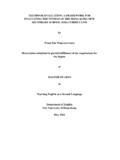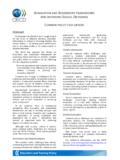Transcription of Georgia Standards of Excellence Curriculum Frameworks ...
1 These materials are for nonprofit educational purposes only. Any other use may constitute copyright infringement. Georgia Standards of Excellence Curriculum Frameworks GSE Grade 6 Unit 5: Area and Volume Mathematics Georgia Department of Education Georgia Standards of Excellence framework GSE Grade 6 Mathematics Unit 5 Mathematics Grade 6 Unit 5: Area and Volume July 2017 Page 2 of 108 Unit 5 Area and Volume TABLE OF CONTENTS OVERVIEW ..3 Standards FOR MATHEMATICAL PRACTICE ..4 Standards FOR MATHEMATICAL CONTENT ..5 BIG IDEAS ..5 ESSENTIAL QUESTIONS ..5 CONCEPTS & SKILLS TO MAINTAIN ..6 FLUENCY ..6 STRATEGIES FOR TEACHING AND LEARNING ..7 MISCONCEPTIONS ..8 SELECTED TERMS AND SYMBOLS ..9 INSTRUCTIONAL RESOURCES/TOOLS ..12 FORMATIVE ASSESSMENT LESSONS (FAL) ..12 SPOTLIGHT TASKS ..13 3-ACT TASKS ..14 Who Put the Tang in Tangram? ..16 Rectangle Wraparound ..24 Finding Areas of Polygons (Spotlight Task).
2 31 What s My Area? ..36 King Arthur s New Table ..40 Area of Composite Figures (FAL) ..47 Finding Surface Area ..48 How Many Ways? ..52 Banana Bread ..59 Volume and Cubes ..62 Packing Our Goods (Spotlight Task) ..71 Painting the Barn (Spotlight Task) ..77 Designing Candy Cartons (FAL) ..84 Candle Box (Short Cycle Task) ..85 Smoothie Box (Short Cycle Task) ..86 Boxing Bracelets ..87 The Filing Cabinet (Spotlight Task) ..94 Culminating Task: STEM Fish Tank Foam Packaging Design ..99 UNIT WEB LINKS ..107 Georgia Department of Education Georgia Standards of Excellence framework GSE Grade 6 Mathematics Unit 5 Mathematics Grade 6 Unit 5: Area and Volume July 2017 Page 3 of 108 OVERVIEW In this unit students will: Find areas of right, equilateral, isosceles, and scalene triangles, and special quadrilaterals. Find areas of composite figures and polygons by composing into rectangles and decomposing into triangles and other shapes.
3 Solve real-world and mathematical problems involving area. Decipher and draw views of rectangular and triangular prisms from a variety of perspectives. Recognize and construct nets for rectangular and triangular prisms. Find the surface area of rectangular and triangular prisms by using manipulatives and by constructing nets. Solve real-world problems that require determining the surface area of rectangular and triangular prisms. Measure and compute volume with fractional edge lengths (like of a unit) using cubic units of measure. Find the volumes of right rectangular prisms by substituting given values for their dimensions into the correct formulas. Make the connection that finding the volume given the length (l) x width (w) is the same as the base (B). Solve real-world problems that require determining the volume of right rectangular prisms. Although the units in this instructional framework emphasize key Standards and big ideas at specific times of the year, routine topics such as estimation, mental computation, and basic computation facts should be addressed on an ongoing basis.
4 Ideas related to the eight practice Standards should be addressed constantly as well. A variety of resources should be utilized to supplement this unit. This unit provides much needed content information, but excellent learning activities as well. The tasks in this unit illustrate the types of learning activities that should be utilized from a variety of sources. Georgia Department of Education Georgia Standards of Excellence framework GSE Grade 6 Mathematics Unit 5 Mathematics Grade 6 Unit 5: Area and Volume July 2017 Page 4 of 108 Standards FOR MATHEMATICAL PRACTICE 1. Make sense of problems and persevere in solving them. Given a rectangular prisms, rectangular pyramids, triangular prisms, and triangular prisms students will find surface area using the net. Students will solve problems by finding the volume of rectangular prisms with fractional edges. Students will decompose and compose polygons to find the area.
5 2. Reason abstractly and quantitatively Students will use their understanding of the value of fractions in solving with area. Students will be able to see and justify the reasoning for decomposing and composing of an irregular polygon/nets using area of triangles and quadrilaterals to solve for surface area. Students will use the relationships between two-dimensional and three-dimensional shapes to understand surface area. 3. Construct viable arguments and critique the reasoning of others. Students will justify how they found surface area of rectangular and triangular prisms, area of irregular polygons, and volume of rectangular prisms with fractal edges by packing it with unit cubes. Students will justify why finding the volume of a rectangular prisms by multiplying the length by the width by the height is the same as multiply the area of the base by the height. Students will review solutions and justify (verbally and written) why the solutions are reasonable.
6 4. Model with mathematics. Use hands on/virtual manipulatives (prisms, pyramids and folding nets) using every day two-dimensional and three-dimensional shapes. Students will draw irregular polygons and decompose into triangles and special quadrilaterals. 5. Use appropriate tools strategically. Students will use a ruler, graph paper two-dimensional and three-dimensional shapes to solve for area, volume and surface area. In addition, students will determine appropriate area formulas to use for given situations. 6. Attend to precision. Students will use appropriate measurement units (square units and cubic units) and correct terminology to justify reasonable solutions. 7. Look for and make use of structure. Students will understand the relationship between the structure of a three-dimensional shape and its volume formula. Students also decompose two-dimensional figures to find areas. 8. Look for and express regularity in repeated reasoning.
7 Students will explain why formula or process is used to solve given problems. Students use properties of figures and properties of operations to connect formulas to surface area and volume. Georgia Department of Education Georgia Standards of Excellence framework GSE Grade 6 Mathematics Unit 5 Mathematics Grade 6 Unit 5: Area and Volume July 2017 Page 5 of 108 Standards FOR MATHEMATICAL CONTENT Solve real-world and mathematical problems involving area, surface area, and volume. Find area of right triangles, other triangles, quadrilaterals, and polygons by composing into rectangles or decomposing into triangles and other shapes; apply these techniques in the context of solving real-world and mathematical problems. Find the volume of a right rectangular prism with fractional edge lengths by packing it with unit cubes of the appropriate unit fraction edge lengths (1/2 u), and show that the volume is the same as would be found by multiplying the edge lengths of the prism.
8 Apply the formulas V = (length) x (width) x (height) and V= (area of base) x (height) to find volumes of right rectangular prisms with fractional edge lengths in the context of solving real-world and mathematical problems. Represent three-dimensional figures using nets made up of rectangles and triangles, and use the nets to find the surface area of these figures. Apply these techniques in the context of solving real-world and mathematical problems. BIG IDEAS The area of irregular and regular polygons can be found by decomposing the polygon into rectangles and triangles. Manipulatives and the construction of nets may be used in computing the surface area of rectangular and triangular prisms, and volume of right rectangular prisms. Formulas may be used to compute the areas of polygons and volumes of right rectangular prisms. Appropriate units of measure should be used when computing the area (square units) of polygons, surface area (square units) and volume of prisms (cubic units).
9 Views of rectangular and triangular prisms may be interpreted and sketched to provide a 2-dimensional representation (nets) of a three dimensional figure. Dimensions of solid figures may have fractional lengths. The volume of a solid figure is the number of same sized cubes filling the space so that there are no gaps and overlaps. ESSENTIAL QUESTIONS How can we find the area of figures? How can we cut and rearrange irregular polygons in order to find their area? How can we use one figure to determine the area of another? How do we measure the area of a shape without a formula for that shape? How are the areas of geometric figures related to each other? How can I use manipulatives and nets to help compute the surface areas of rectangular and triangular prisms and pyramids? Georgia Department of Education Georgia Standards of Excellence framework GSE Grade 6 Mathematics Unit 5 Mathematics Grade 6 Unit 5: Area and Volume July 2017 Page 6 of 108 What kinds of problems can be solved using surface areas of rectangular and triangular prisms and pyramids?
10 How can I interpret and sketch views of rectangular and triangular prisms and pyramids? How can I use formulas to determine the volume of right rectangular prisms? How can I determine the appropriate units of measure that should be used when computing the volume and surface area of prisms? What kinds of problems can be solved using volumes of fundamental solid figures? In what ways can I measure the volume of a rectangular prism with fractional edge lengths? CONCEPTS & SKILLS TO MAINTAIN number sense computation with whole numbers, fractions, and decimals, including application of order of operations multiplication and division of fractions formulas for finding area, surface area and volume area measures in square units and volume measures in cubic units properties of polygons, 2-D, and 3-D shapes FLUENCY It is expected that students will continue to develop and practice strategies to build their capacity to become fluent in mathematics and mathematics computation.













